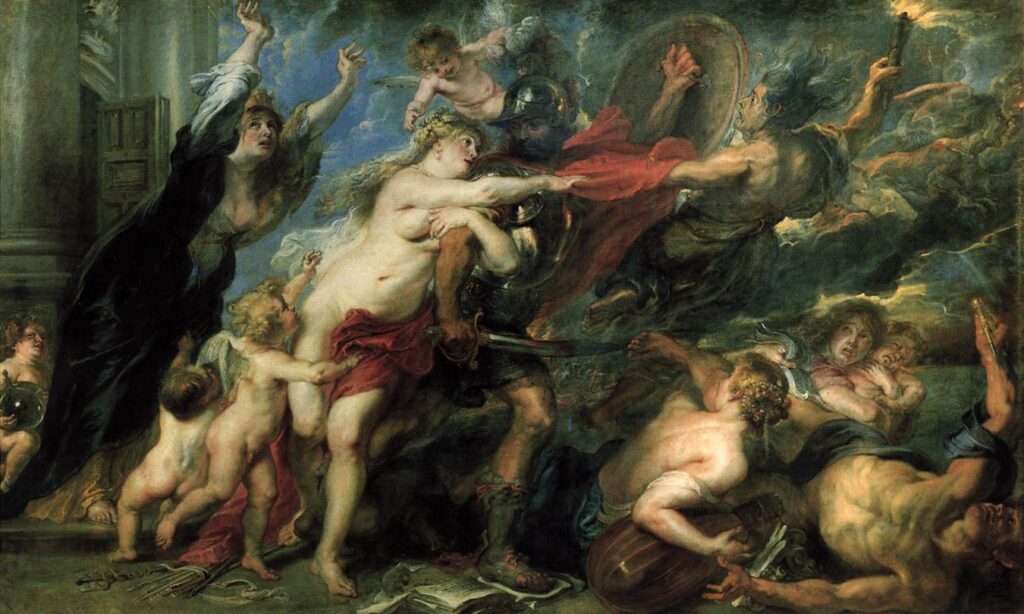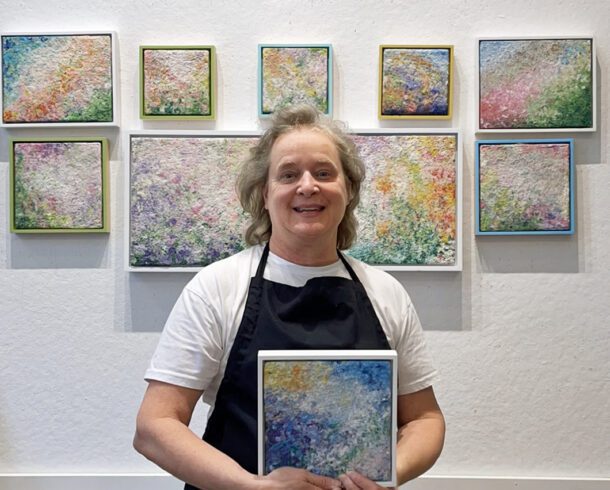There have been a lot of images of Picasso’s Guernica lately, and sadly for good reason as we see images of bombing raids over Ukrainian cities. As an art history professor, I have been thinking of other paintings that have historically depicted war. Here are some of my favorites.
Mars, the god of war, is presented with a choice. Should he continue his march into war, or should he show mercy and retreat? Figures representing the different qualities of war and peace surround him, encouraging him to follow their example. Alecto, one of the three goddesses of vengeance (known as the Furies), pulls him onwards, while Venus, the goddess of love, attempts to restrain him.
On the left, a woman symbolising Europe throws her arms up in distress at the prospect of war. On the right, the realities of war are laid bare: the monsters of Plague and Famine breathe fire over a cowering mass of bodies personifying the joys of peacetime – Harmony, Fecundity, Maternity and Charity. Despite the artist’s convincing illustration of the horrors of war, contemporary viewers would have known that war is in Mars’ nature, and that even the tempting persuasions of his lover, Venus, will not be enough to stop him. Resource: https://www.nationalgallery.org.uk/paintings/after-peter-paul-rubens-the-horrors-of-war
In 1807, Napoleon, bent on conquering the world, brought Spain’s king, Charles IV, into alliance with him in order to conquer Portugal. Napoleon’s troops poured into Spain, supposedly just passing through. But Napoleon’s real intentions soon became clear: the alliance was a trick. The French were taking over. Joseph Bonaparte, Napoleon’s brother, was the new king of Spain. On May 2, 1808, hundreds of Spaniards rebelled. On May 3, these Spanish freedom fighters were rounded up and massacred by the French. Their blood literally ran through the streets of Madrid. Even though Goya had shown French sympathies in the past, the slaughter of his countrymen and the horrors of war made a profound impression on the artist. He commemorated both days of this gruesome uprising in paintings. Although Goya’s Second of May (above) is a tour de force of twisting bodies and charging horses reminiscent of Leonardo’s Battle of Anghiari, his The Third of May, 1808 in Madrid is acclaimed as one of the great paintings of all time, and has even been called the world’s first modern painting. We see row of French soldiers aiming their guns at a Spanish man, who stretches out his arms in submission both to the men and to his fate. A country hill behind him takes the place of an executioner’s wall. A pile of dead bodies lies at his feet, streaming blood. To his other side, a line of Spanish rebels stretches endlessly into the landscape. They cover their eyes to avoid watching the death that they know awaits them. The city and civilization is far behind them. Even a monk, bowed in prayer, will soon be among the dead. Goya’s painting has been lauded for its brilliant transformation of Christian iconography and its poignant portrayal of man’s inhumanity to man. The central figure of the painting, who is clearly a poor laborer, takes the place of the crucified Christ; he is sacrificing himself for the good of his nation. The lantern that sits between him and the firing squad is the only source of light in the painting, and dazzlingly illuminates his body, bathing him in what can be perceived as spiritual light. His expressive face, which shows an emotion of anguish that is more sad than terrified, echoes Christ’s prayer on the cross, “Forgive them Father, they know not what they do.” Close inspection of the victim’s right hand also shows stigmata, referencing the marks made on Christ’s body during the Crucifixion.
The man’s pose not only equates him with Christ, but also acts as an assertion of his humanity. The French soldiers, by contrast, become mechanical or insect-like. They merge into one faceless, many-legged creature incapable of feeling human emotion. Nothing is going to stop them from murdering this man. The deep recession into space seems to imply that this type of brutality will never end. This depiction of warfare was a drastic departure from convention. In 18th century art, battle and death was represented as a bloodless affair with little emotional impact. Even the great French Romanticists were more concerned with producing a beautiful canvas in the tradition of history paintings, showing the hero in the heroic act, than with creating emotional impact. Goya’s painting, by contrast, presents us with an anti-hero, imbued with true pathos that had not been seen since, perhaps, the ancient Roman sculpture of The Dying Gaul. Goya’s central figure is not perishing heroically in battle, but rather being killed on the side of the road like an animal. Both the landscape and the dress of the men are nondescript, making the painting timeless. This is certainly why the work remains emotionally charged today. Source: https://www.khanacademy.org/humanities/becoming-modern/romanticism/romanticism-in-spain/a/goya-third-of-may-1808
Guernica is an icon of modern art, the Mona Lisa for our time. As Leonardo da Vincievoked a Renaissance ideal of serenity and self-control, Guernica should be seen as Picasso’s comment on what art can actually contribute towards the self-assertion that liberates every human being and protects the individual against overwhelming forces such as political crime, war, and death.
10 Facts of Guernica
1. Guernica, Picasso’s most important political painting, has remained relevant as a work of art and as a symbol of protest, and it kept the memory of the Basque town’s nightmare alive. While Picasso was living in Nazi-occupied Paris during World War II, one German officer allegedly asked him, upon seeing a photo of Guernica in his apartment, “Did you do that?” Picasso responded, “No, you did.”
2. Guernica was a commissioned painting. After the bombing of Guernica, Picasso was made aware of what had gone on in his country of origin. At the time, he was working on a mural for the Paris Exhibition to be held in the summer of 1937, commissioned by the Spanish Republican government. He deserted his original idea and on 1 May 1937, began on Guernica. This captivated his imagination unlike his previous idea, on which he had been working somewhat dispassionately, for a couple of months. It is interesting to note, however, that at its unveiling at the Paris Exhibition that summer, it garnered little attention. It would later attain its power as such a potent symbol of the destruction of war on innocent lives.
3. Perhaps because Picasso learned about the Guernica bombing by reading an article in newspaper, the suggestion of torn newsprint appears in the painting. It doubles as the horse’s chain mail.
4. Picasso’s patriotism and sense of justice outweighed physical location. He had not been to Spain, the country of his birth, for several years when the Nazis bombed the Spanish town of Guernica in 1937. He was living in Paris at the time, and never returned to his birthplace to live. Nevertheless, the attack, which killed mainly women and children, shook the artist to the core.
5. In 1974, an antiwar activist and artist, Tony Shafrazi, would deface the mural with red spray paint as a protest statement. It was on display at New York’s Metropolitan Museum of Art at the time. Curators immediately cleaned the painting, and Shafrazi went to jail, charged with criminal mischief.
6. Picasso was adamant that Guernica remains at the Met until Spain re-established a democratic republic. It would not be until 1981, after both the artist’s and Franco’s deaths, that Spanish negotiators were finally able to bring the mural home.
7. During his creation of “Guernica,” Picasso allowed a photographer to chronicle its progress. Historians believe that the resulting black and white photos inspired the artist to revise his earlier colored versions of the artwork to a starker, more impactful palette.
8. Not only did the artist use lack of color to express the starkness of the aftermath of the bombing, he also specially ordered house paint that had a minimum amount of gloss. The matte finish, in addition to the shades of grey, white and blue-black, set an outspoken yet unadorned tone for the artwork.
9. The mural contains some hidden images. One of them is a skull, which is superimposed over the horse’s body. Another is a bull formed from the horse’s bent leg. Three daggers replace tongues in the mouths of the horse, the bull and the screaming woman.
10. Two of the artist’s signature images, the Minotaur and the Harlequin, figure in Guernica. The Minotaur, which symbolizes irrational power, dominates the left side of the work. The harlequin, a partially hidden component just off-center to the left, cries a diamond-shaped tear. The harlequin traditionally symbolizes duality. In the iconography of Picasso’s art, it is a mystical symbol with power over life and death. Perhaps the artist inserted the harlequin to counterbalance the deaths he depicted in the mural. Sources: https://www.pablopicasso.org/guernica.jsp




